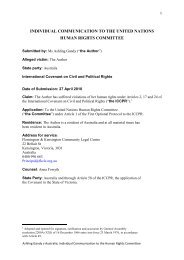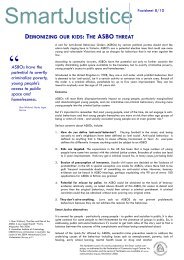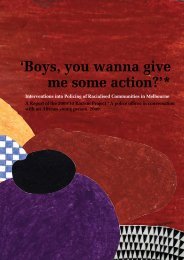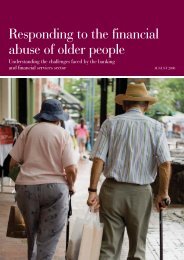Reducing Ethnic Profiling in the European Union - Open Society ...
Reducing Ethnic Profiling in the European Union - Open Society ...
Reducing Ethnic Profiling in the European Union - Open Society ...
- No tags were found...
Create successful ePaper yourself
Turn your PDF publications into a flip-book with our unique Google optimized e-Paper software.
Observational studies were pioneered <strong>in</strong> <strong>the</strong> United States to provide statistical<strong>in</strong>formation for court cases challeng<strong>in</strong>g ethnic profil<strong>in</strong>g on state highways. In a landmarkcase, a New Jersey court relied on statistical evidence obta<strong>in</strong>ed through an observationalstudy of drivers on <strong>the</strong> New Jersey Turnpike to determ<strong>in</strong>e that <strong>the</strong> New JerseyState Police were engag<strong>in</strong>g <strong>in</strong> ethnic profil<strong>in</strong>g. 162 The study revealed that although only13.5 percent of all drivers on <strong>the</strong> highway were black, blacks constituted 37.4 percentof those stopped; that is, black people were 4.85 times more likely to be stopped thanwhites. Observational analysis is now widely accepted <strong>in</strong> <strong>the</strong> United States as a reliabletool for measur<strong>in</strong>g ethnic profil<strong>in</strong>g. Court cases <strong>in</strong> <strong>the</strong> US us<strong>in</strong>g observational studieshave established a threshold for determ<strong>in</strong><strong>in</strong>g when ethnic profil<strong>in</strong>g is tak<strong>in</strong>g place. Ifstops are be<strong>in</strong>g conducted equally aga<strong>in</strong>st all ethnic groups, <strong>the</strong> ratios would be 1.0, <strong>in</strong>dicat<strong>in</strong>gthat blacks are no more likely to be stopped that whites. Odds ratios between 1.0and 1.5 are most likely benign but when <strong>the</strong> odds ratio is greater than 1.5 it is likely thatethnic profil<strong>in</strong>g is tak<strong>in</strong>g place and ethnic groups are be<strong>in</strong>g targeted for police stops. 163It is important to bear <strong>in</strong> m<strong>in</strong>d that observational studies are expensive to conductand have never been used to provide trend analysis (which would require repeatedstudies at set <strong>in</strong>tervals of time to illustrate changes <strong>in</strong> police practices), create annualstatistics, or as a basis for ongo<strong>in</strong>g monitor<strong>in</strong>g of policies designed to reduce ethnicprofil<strong>in</strong>g. Ra<strong>the</strong>r, <strong>the</strong>y provide an important snapshot for determ<strong>in</strong><strong>in</strong>g disproportionalityat a given time and place. The follow<strong>in</strong>g three case studies show how observationalstudies have been used to measure <strong>the</strong> extent of ethnic profil<strong>in</strong>g when ethnic data werenot available.RUSSIA<strong>Ethnic</strong> <strong>Profil<strong>in</strong>g</strong> <strong>in</strong> <strong>the</strong> Moscow MetroIn 2006, <strong>the</strong> <strong>Open</strong> <strong>Society</strong> Justice Initiative, <strong>in</strong> partnership with JURIX and LamberthConsult<strong>in</strong>g, undertook an observational study of ethnic profil<strong>in</strong>g by <strong>the</strong> police <strong>in</strong> <strong>the</strong>Moscow Metro system. 164 Stations where observers could clearly monitor stops wereselected for observation. Monitors were tra<strong>in</strong>ed to visually categorize people <strong>in</strong>tosimple ethnic categories (“Slavs,” “m<strong>in</strong>orities” and “o<strong>the</strong>r”). Observers monitoredspecific locations at randomly selected days and recorded a benchmark of 33,760persons at those locations. F<strong>in</strong>ally, monitors observed police stops, record<strong>in</strong>g ethnicity,sex and age. Where possible, <strong>in</strong>dividuals stopped by <strong>the</strong> police were <strong>in</strong>terviewed by <strong>the</strong>observers to determ<strong>in</strong>e <strong>the</strong>ir perceptions of <strong>the</strong> encounter with <strong>the</strong> police.88 ETHNIC MONITORING AND LAW ENFORCEMENT DATA-GATHERING
















